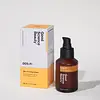What's inside
What's inside
 Key Ingredients
Key Ingredients

 Benefits
Benefits

 Concerns
Concerns

 Ingredients Side-by-side
Ingredients Side-by-side

Water
Skin ConditioningGlycerin
HumectantButyrospermum Parkii Butter
Skin ConditioningHelianthus Annuus Seed Oil
EmollientCarthamus Tinctorius Seed Oil
MaskingGlycereth-7 Trimethyl Ether
Skin ConditioningNiacinamide
SmoothingSilica
AbrasiveEthyl Linoleate
EmollientHydrogenated Lecithin
EmulsifyingHydroxyacetophenone
AntioxidantPolyacrylate-13
C12-16 Alcohols
EmollientPoria Cocos Extract
Skin ConditioningPolyisobutene
Hydrogenated Phosphatidylcholine
EmulsifyingPolyacrylate Crosspolymer-6
Emulsion StabilisingPolysorbate 20
EmulsifyingHordenine
Skin ProtectingPalmitic Acid
EmollientSodium Dehydroacetate
PreservativeTetrasodium Glutamate Diacetate
Tetrahexyldecyl Ascorbate
AntioxidantTocopheryl Acetate
AntioxidantSilicon
AbrasiveArginine
MaskingGlycine
BufferingCitric Acid
BufferingWater, Glycerin, Butyrospermum Parkii Butter, Helianthus Annuus Seed Oil, Carthamus Tinctorius Seed Oil, Glycereth-7 Trimethyl Ether, Niacinamide, Silica, Ethyl Linoleate, Hydrogenated Lecithin, Hydroxyacetophenone, Polyacrylate-13, C12-16 Alcohols, Poria Cocos Extract, Polyisobutene, Hydrogenated Phosphatidylcholine, Polyacrylate Crosspolymer-6, Polysorbate 20, Hordenine, Palmitic Acid, Sodium Dehydroacetate, Tetrasodium Glutamate Diacetate, Tetrahexyldecyl Ascorbate, Tocopheryl Acetate, Silicon, Arginine, Glycine, Citric Acid
Water
Skin ConditioningParaffinum Liquidum
EmollientGlycerin
HumectantCaprylic/Capric Triglyceride
MaskingPEG-12
HumectantOenothera Biennis Oil
EmollientGlyceryl Stearate
EmollientPEG-100 Stearate
Polyacrylate-13
Aquaphilus Dolomiae Extract
Skin ConditioningArginine
MaskingCitric Acid
BufferingEvening Primrose Oil/Palm Oil Aminopropanediol Esters
Skin ConditioningGlycine
BufferingPolyisobutene
Polysorbate 20
EmulsifyingSodium Acetate
BufferingSorbitan Isostearate
EmulsifyingTocopherol
AntioxidantWater, Paraffinum Liquidum, Glycerin, Caprylic/Capric Triglyceride, PEG-12, Oenothera Biennis Oil, Glyceryl Stearate, PEG-100 Stearate, Polyacrylate-13, Aquaphilus Dolomiae Extract, Arginine, Citric Acid, Evening Primrose Oil/Palm Oil Aminopropanediol Esters, Glycine, Polyisobutene, Polysorbate 20, Sodium Acetate, Sorbitan Isostearate, Tocopherol
 Reviews
Reviews

Ingredients Explained
These ingredients are found in both products.
Ingredients higher up in an ingredient list are typically present in a larger amount.
Arginine is an amino acid that is important for human development. Your body uses is it to produce hair keratin and skin collagen.
As a cosmetic ingredient, Arginine has antioxidant properties and can also help repair damaged skin. This ingredient is derived either synthetically or from animals.
Arginine isn't fungal acne safe when used in the presence of other lipids (fats, fatty acids, oils, esters, etc). Oils and fats occur naturally within the skin, so take caution when using Arginine if you're prone to fungal acne.
Learn more about ArginineCitric Acid is an alpha hydroxy acid (AHA) naturally found in citrus fruits like oranges, lemons, and limes.
Like other AHAs, citric acid can exfoliate skin by breaking down the bonds that hold dead skin cells together. This helps reveal smoother and brighter skin underneath.
However, this exfoliating effect only happens at high concentrations (20%) which can be hard to find in cosmetic products.
Due to this, citric acid is usually included in small amounts as a pH adjuster. This helps keep products slightly more acidic and compatible with skin's natural pH.
In skincare formulas, citric acid can:
While it can provide some skin benefits, research shows lactic acid and glycolic acid are generally more effective and less irritating exfoliants.
Most citric acid used in skincare today is made by fermenting sugars (usually from molasses). This synthetic version is identical to the natural citrus form but easier to stabilize and use in formulations.
Read more about some other popular AHA's here:
Learn more about Citric AcidGlycerin is already naturally found in your skin. It helps moisturize and protect your skin.
A study from 2016 found glycerin to be more effective as a humectant than AHAs and hyaluronic acid.
As a humectant, it helps the skin stay hydrated by pulling moisture to your skin. The low molecular weight of glycerin allows it to pull moisture into the deeper layers of your skin.
Hydrated skin improves your skin barrier; Your skin barrier helps protect against irritants and bacteria.
Glycerin has also been found to have antimicrobial and antiviral properties. Due to these properties, glycerin is often used in wound and burn treatments.
In cosmetics, glycerin is usually derived from plants such as soybean or palm. However, it can also be sourced from animals, such as tallow or animal fat.
This ingredient is organic, colorless, odorless, and non-toxic.
Glycerin is the name for this ingredient in American English. British English uses Glycerol/Glycerine.
Learn more about GlycerinThis ingredient is an amino acid that helps build proteins and moisturizes skin. It is already present in our skin as our bodies produce them naturally.
Glycine already plays a role in helping keep our skin moisturized as amino acids transport moisture throughout our skin.
As collagen is made up of glycine and other amino acids, it is believed glycine may help our skin produce more collagen.
Learn more about GlycinePolyacrylate-13 is a type of acrylate polymer. Acrylate polymers are commonly used as adhesives in cosmetics.
Polyacrylate-13 creates a film to protect the skin. It is also used to thicken and stabilize a product. It works by making water a gel-like consistency. This gel consistency helps suspend particles.
Polyacrylate-13 is a copolymer of acrylic acid, acrylamide, sodium acrylate, sodium acryloyldimethyltaurate monomers
Learn more about Polyacrylate-13Polyisobutene is a synthetic polymer made from isobutene.
It is a film-forming agent and helps bind ingredients together.
Polyisobutene is not absorbed by the skin.
Learn more about PolyisobutenePolysorbate 20 is made by combining ethoxylation of sorbitan, ethylene oxide, and lauric acid. It is a mild cleansing agent, surfactant, and emulsifier.
As a surfactant, it helps collect dirt and oils for washing. Emulsifiers prevent oils and water from separating.
Polysorbate 20 also adds scent to a product. Since it is made using sorbitol, it has a sweet scent. Sorbitol can also be found in fruits such as apples and peaches.
The lauric acid used to create Polysorbate 20 is often derived from coconuts.
Polysorbate 20 may not be fungal acne safe.
Learn more about Polysorbate 20Water. It's the most common cosmetic ingredient of all. You'll usually see it at the top of ingredient lists, meaning that it makes up the largest part of the product.
So why is it so popular? Water most often acts as a solvent - this means that it helps dissolve other ingredients into the formulation.
You'll also recognize water as that liquid we all need to stay alive. If you see this, drink a glass of water. Stay hydrated!
Learn more about Water